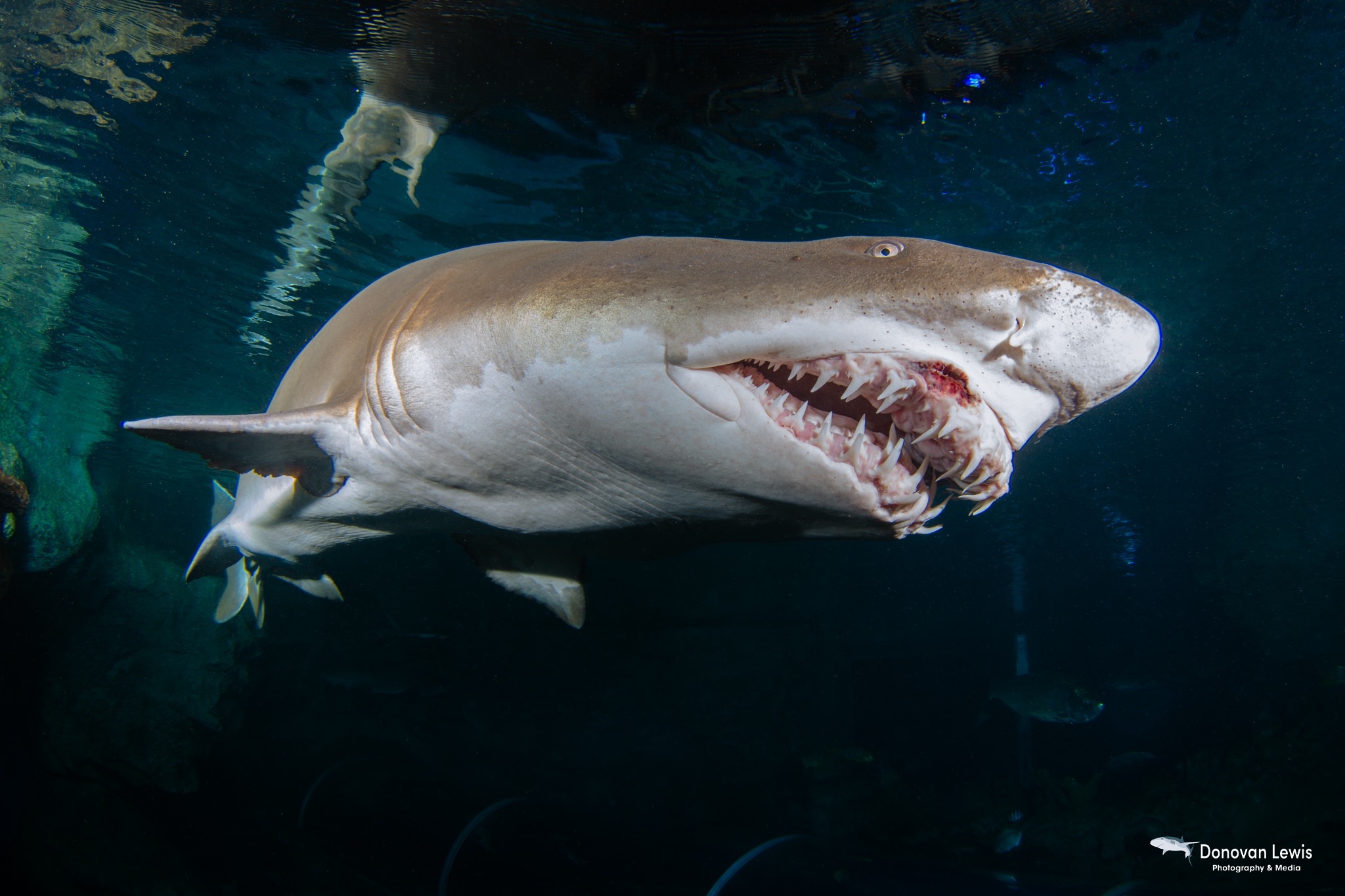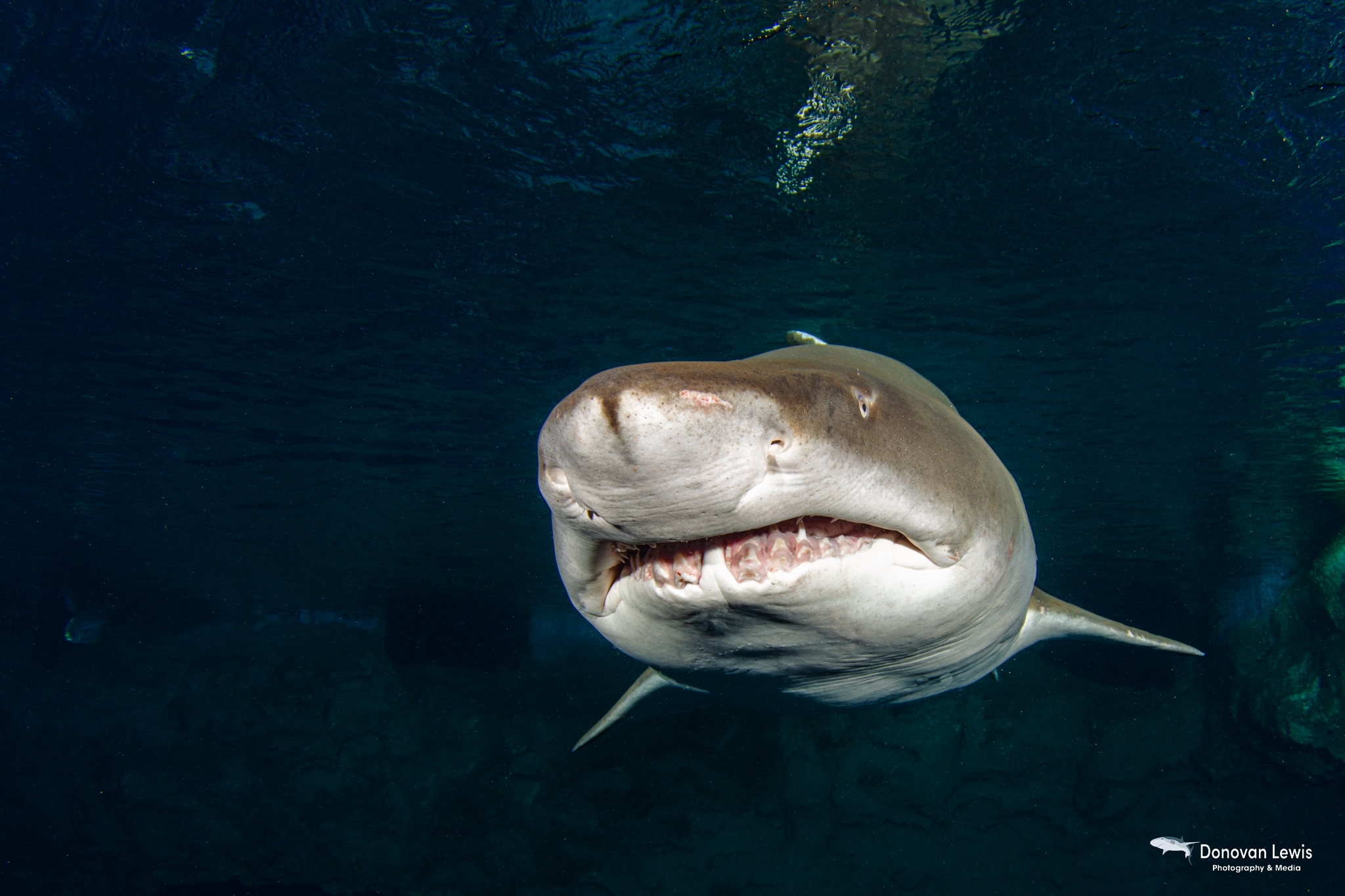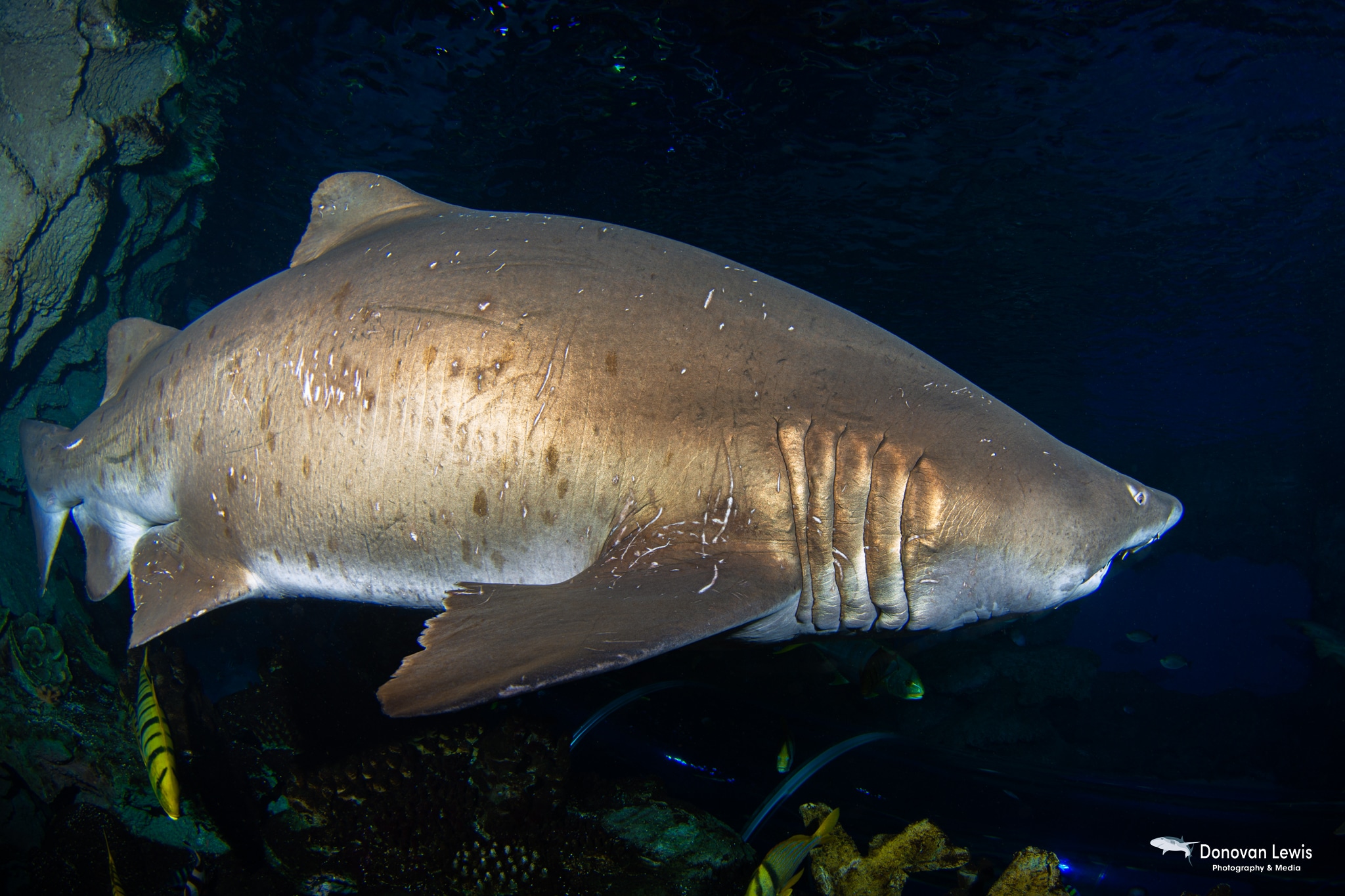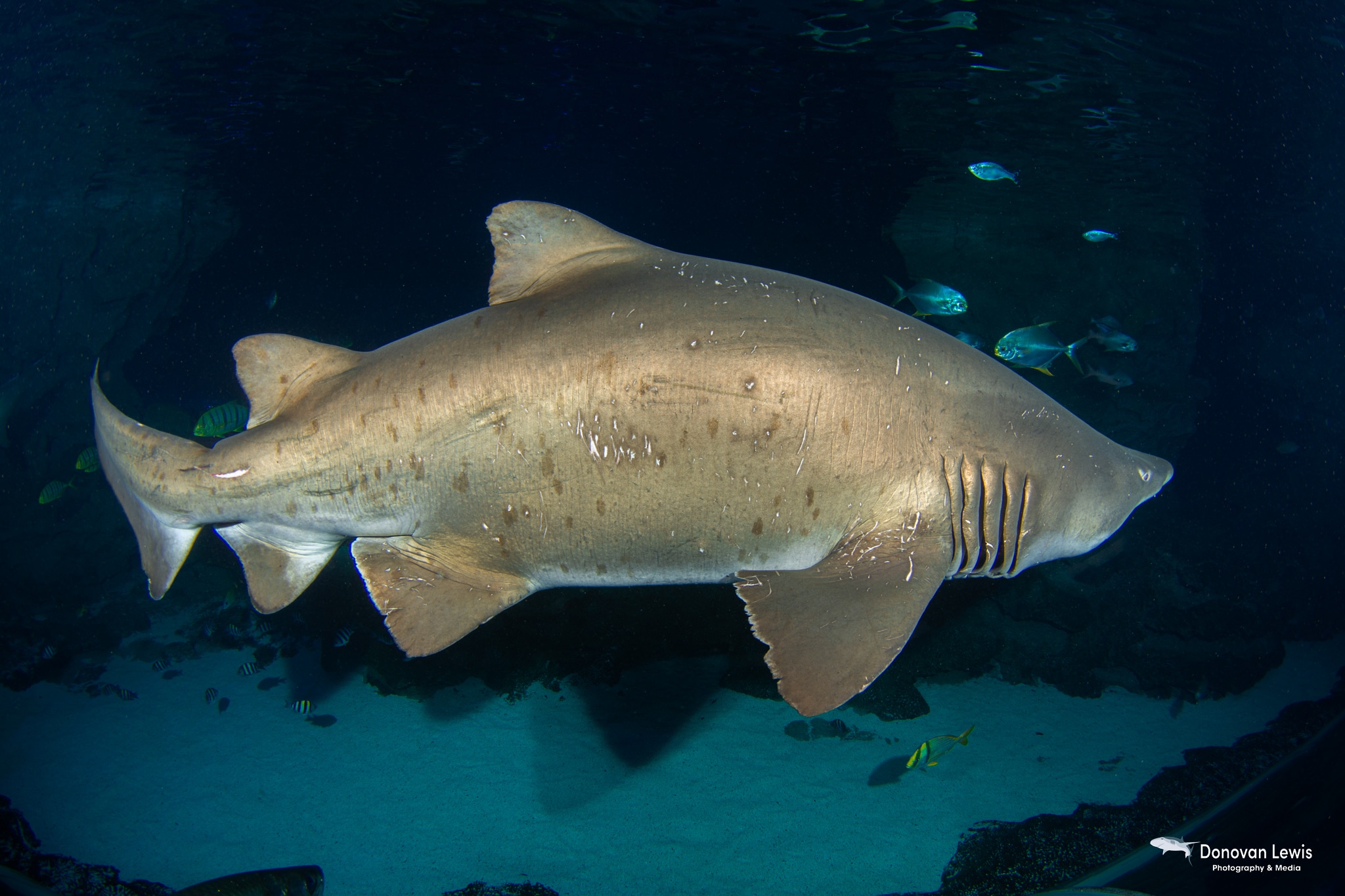Marine Life & Conservation Blogs
Love is in the air at Blue Planet Aquarium

Every year between the end of January and mid-May when the water is at its coldest and begins to warm up for summer, Blue Planet Aquarium has its annual Sand Tiger Shark mating season. During this time of year, the dynamics in the tank completely change, from what are usually slow moving and often sleeping sharks turn into fast moving Sharks who have only one thing on their mind.
In previous blogs I’ve mentioned how relaxed the Sharks are, but during this time the Sharks are at the complete opposite end of the scale, sometimes seeming oblivious to our presence, they can tend to almost “play chicken” with the divers, swimming very close, which can sometimes make us jump a little. Even with this change in behaviour however the animals are still quite easy to work with and we always respect their boundaries and rules as it is their home at the end of the day.
The changes in behaviour start around mid to late January with a huge reduction in appetite for all our Sand Tigers, they will go down to eating almost nothing throughout the mating season, we even have them spit food out after grabbing it.
The next sign usually starts with the males moving a lot faster and will duck and dive between the different levels in the tank, it can be chaotic one day and then almost nothing the next, on the opposite end the females will slow right down and tend to spend a large amount of time either on or near the bottom.
It is like this for about a month before the action really starts, the next sign is what’s known as “tracking”, this is where you will have the female of interest at the front with the alpha male close behind her, with the subordinate males trailing behind him. This happens for a couple of weeks until around March where the height of mating season starts, after a month or so of tracking and a little bit of bickering there will be an “alpha” male who will control mating in the tank. Alpha males will then protect the area where females are congregating and will then force less dominant males out by snapping their jaws at them, snapping tends to be enough to force males out, however seeing bite marks on the males is not uncommon.
When Sharks mate the males tend to bite the females around their pectoral fins or on their sides, this is done to help hold themselves in place during mating and to make it easier to mate by slowing the female down, females will often resist but will concede due to the extra weight, this could be the female testing the male’s fitness, but we honestly don’t know. The male sharks sex organs are known as Claspers, two small appendages that trail behind the Sharks pelvic fins and its these that transfer the Sperm to the female during mating, they have two so that they’re able to effectively mate no matter what side they approach the female on.
When males are finished and let go, they can sometimes leave teeth embedded in the females which will fall out after a few days and don’t affect the female long term, this does often result with toothless males during mating season, and even for a short time after it has finished, which our guests are often surprised to see gummy Sand Tigers in our exhibit. Along with having toothless males the females also become covered from nose to tail in love bites, and during rather amorous seasons the dive team will refer to the females as pin cushion Sharks due to how much they resemble pin cushions, never fear however because mere days after mating season has finished most, if not all, of the wounds on a female would have healed and results in very minor scarring or marks.
Females will mate with numerous males throughout a season, moving between different areas and mating with many alpha males who control those areas, in the case of Blue Planets main tank our males tend to gain and lose alpha status rather regularly, thus allowing them mating rights. Female Sand Tigers have two Uterus’s which can contain up to 5 pups each. After the mating season is over, females become pregnant in a rather remarkable way. Sand Tigers are known as oophagous which is where the developing embryos will feed on undeveloped eggs produced by the mother throughout her 9–12-month pregnancy.
But that’s not all, once an individual or individuals reach a certain size, they will actually turn on their sibling and begin to feed on them, this is called intrauterine cannibalism. This will continue until there is a single fully toothed pup in each uterus, however triplets have been recorded which believed to be two individuals from the same womb who were full sibling who teamed up, and one from the other womb.
This method of eating siblings is believed to be an adaptation by male Sand Tigers with whom who can father the most well-armed, active hunting embryos as described by a scientist called Damian Chapman.
Unfortunately, Blue Planet has never had a captive natural birth in our main exhibit now there could be many reasons as to why this is the case, and we have a few theories amongst the team but unfortunately, we just can’t say for certain what those are. The reasons as to why they aren’t breeding is something that been discussed for many years in aquariums across the globe as unfortunately captive breeding very limited with only a handful of recorded births worldwide.
Sand Tiger Sharks have one of the lowest reproductive rates of any Shark Species giving birth to only two pups every other year as the females take a rest year in between, on top of this Sand Tigers don’t become sexually mature until they’re between 6-7 if they’re a male, females will not become mature until they’re 9-10 this on top of the fact that the maximum lifespan recorded for a Sand Tiger in the wild is 15-17 years means that to be generous, a female may only give birth to a maximum of 16 pups throughout their lifetime. Now these natural adaptations have served them well throughout the last 450 million years but now they are a handicap.
Sand Tigers are unfortunately at threat, with some populations such as those in Europe, the Mediterranean and Eastern Australia classified as Critically Endangered. Sand Tiger Sharks were also the first Shark species to be put on the endangered species list and given full protection which was first done in Australia.
With all the odds stacking against them its now even more imperative that we learn more about these incredible animals and how to breed them effectively to create a captive population as a contingency plan in case things in the wild take a nosedive. Therefore, Zoos and Aquariums are important to the wild members of a species with housed members of the species, helping ensure their survival and as acting as ambassadors to the wild ancestors by educating our guests and the public for many years to come. Now rest assured although we haven’t yet been able to breed Sand Tiger Sharks in our main exhibit, we’re working hard to better understand and figure out how we can in the not-so-distant future.
For more about Blue Planet Aquarium visit their website by click here.
Blogs
Invitation from The Ocean Cleanup for San Francisco port call

6 years ago, The Ocean Cleanup set sail for the Great Pacific Garbage Patch with one goal: to develop the technology to be able to relegate the patch to the history books. On 6 September 2024, The Ocean Cleanup fleet returns to San Francisco bringing with it System 03 to announce the next phase of the cleanup of the Great Pacific Garbage Patch and to offer you a chance to view our cleanup system up-close and personal.
We look forward to seeing you there.
To confirm your presence, please RSVP to press@theoceancleanup.com
PROGRAM
Join The Ocean Cleanup as our two iconic ships and the extraction System 03 return to San Francisco, 6 years and over 100 extractions after we set sail, to create and validate the technology needed to rid the oceans of plastic.
Our founder and CEO, Boyan Slat, will announce the next steps for the cleanup of the Great Pacific Garbage Patch. Giving you a chance to view our cleanup system and the plastic extracted.
Hear important news on what’s next in the mission of The Ocean Cleanup as it seeks to make its mission of ridding the world’s oceans of plastic an achievable and realistic goal.
Interviews and vessel tours are available on request.
PRACTICALITIES
Date: September 6, 2024
Press conference: 12 pm (noon)
Location: The Exploratorium (Google Maps)
Pier 15 (Embarcadero at Green Street), San Francisco, CA
Parking: Visit The Exploratorium’s website for details.
RSVP: press@theoceancleanup.com
Video & photo material from several viewing spots around the bay
We look forward to seeing you there!
ABOUT THE OCEAN CLEANUP
The Ocean Cleanup is an international non-profit that develops and scales technologies to rid the world’s oceans of plastic. They aim to achieve this goal through a dual strategy: intercepting in rivers to stop the flow and cleaning up what has already accumulated in the ocean. For the latter, The Ocean Cleanup develops and deploys large-scale systems to efficiently concentrate the plastic for periodic removal. This plastic is tracked and traced to certify claims of origin when recycling it into new products. To curb the tide via rivers, The Ocean Cleanup has developed Interceptor™ Solutions to halt and extract riverine plastic before it reaches the ocean. As of June 2024, the non-profit has collected over 12 million kilograms (26.4 million pounds) of plastic from aquatic ecosystems around the world. Founded in 2013 by Boyan Slat, The Ocean Cleanup now employs a broadly multi-disciplined team of approximately 140. The foundation is headquartered in Rotterdam, the Netherlands, and opened its first regional office in Kuala Lumpur, Malaysia, in 2023.
Find out more about The Ocean Cleanup at www.theoceancleanup.com.
Blogs
Smart Shark Diving: The Importance of Awareness Below the Surface

By: Wael Bakr
Introduction to Shark Diving Awareness
In the realm of marine life, few creatures captivate our interest, and sometimes our fear, like the shark. This fascination often finds a home in the hearts of those who venture beneath the waves, particularly scuba divers who love shark diving. It’s here that shark awareness takes the spotlight. Shark awareness is not just about understanding these magnificent creatures; it’s about fostering respect, dispelling fear, and promoting conservation. As Jacques Cousteau once said, “People protect what they love.” And to love something, one must first understand it.
Shark awareness is not a mere fascination; it’s a responsibility that we owe to our oceans and their inhabitants. From the smallest reef shark to the colossal great white, each species plays a crucial role in the underwater ecosystem. Our understanding and appreciation of these creatures can help ensure their survival.
However, shark awareness isn’t just about protecting the sharks; it’s also about protecting ourselves. As scuba divers, we share the underwater world with these magnificent creatures. Understanding them allows us to dive safely and responsibly, enhancing our experiences beneath the waves.
Importance of Shark Awareness in Scuba Diving
The relevance of shark awareness in scuba diving cannot be overstated. Sharks, like all marine life, are an integral part of the underwater ecosystem. Their presence and behavior directly influence our experiences as divers. By understanding sharks, we can better appreciate their role in the ocean, anticipate their actions, and reduce potential risks.
Awareness is crucial for safety when shark diving. Despite their often-misunderstood reputation, sharks are generally not a threat to humans. However, like any wild animal, they can pose risks if provoked or threatened. By understanding shark behavior, we can identify signs of stress or aggression and adjust our actions accordingly. This not only protects us but also respects the sharks and their natural behaviors.
Moreover, shark awareness enriches our diving experiences. Observing sharks in their natural habitat is a thrilling experience. Understanding them allows us to appreciate this spectacle fully. It’s not just about seeing a shark; it’s about understanding its role in the ecosystem, its behavior, and its interaction with other marine life. This depth of knowledge adds a new dimension to our diving experiences.
Understanding Shark Behavior: The Basics
The first step in shark awareness is understanding shark behavior. Sharks are not the mindless predators they are often portrayed to be. They are complex creatures with unique behaviors and communication methods. Understanding these basics can significantly enhance our interactions with them.
Sharks communicate primarily through body language. By observing their movements, we can gain insights into their mood and intentions. For example, a relaxed shark swims with slow, fluid movements. In contrast, a stressed or agitated shark may exhibit rapid, jerky movements or other signs of discomfort such as gill flaring.
Sharks also use their bodies to express dominance or assertiveness. A dominant shark may swim with its pectoral fins pointed downwards, while a submissive shark may swim with its fins flattened against its body. Understanding these signals can help us interpret shark behavior accurately and respond appropriately.
How Shark Awareness Enhances Scuba Diving Experiences
Shark awareness significantly enhances our scuba diving experiences. It transforms encounters with sharks from mere sightings into meaningful interactions. Knowledge is power, and in this case, it’s the power to appreciate, respect, and safely interact with one of the ocean’s most fascinating inhabitants.
A thorough understanding of behavior when shark diving allows us to interpret their actions and responses accurately. It enables us to recognize signs of stress or aggression and adjust our behavior accordingly. This not only ensures our safety but also promotes responsible interactions that respect the sharks and their natural behaviors.
Furthermore, shark awareness adds a new layer of depth to our diving experiences. It’s one thing to see a shark; it’s another to understand its behavior, its role in the ecosystem, and its interactions with other marine life. This depth of understanding enriches our experiences and fosters a deeper appreciation for our underwater world.
Misconceptions About Sharks: Busting the Myths
Unfortunately, sharks are often misunderstood, feared, and even demonized. These misconceptions can be detrimental, not only to our experiences as divers but also to shark conservation efforts. As part of shark awareness, it’s important to debunk these myths and present sharks in their true light.
First and foremost, sharks are not mindless killing machines. They are complex creatures with unique behaviors and communication methods. They are not interested in humans as prey and, in most cases, prefer to avoid us.
Secondly, not all sharks are dangerous. Out of over 500 species of sharks, only a handful are considered potentially harmful to humans. Most sharks are harmless, and even those that can pose a threat are unlikely to attack unless provoked.
Lastly, sharks are not invincible. They are vulnerable to a host of threats, most notably human activities such as overfishing and habitat destruction. They need our understanding and protection, not our fear and persecution.
Shark Behavior: What to Expect When Scuba Diving
When scuba diving, it’s important to know what to expect from sharks. Most encounters with sharks are peaceful and awe-inspiring. However, as with any wild animal, it’s essential to be prepared and understand their behavior.
Most sharks are shy and cautious creatures. They are likely to observe you from a distance, often circling around to get a better look. This is normal behavior and not a sign of aggression.
However, if a shark becomes agitated or feels threatened, it may exhibit signs of stress such as rapid, jerky movements or gill flaring. In such cases, it’s essential to remain calm, avoid sudden movements, and slowly retreat if possible.
Remember, every encounter with a shark is an opportunity to observe and learn. With understanding and respect, these encounters can be safe, enriching, and truly unforgettable experiences.
Practical Tips for Shark Awareness During Scuba Diving
Being aware of sharks during scuba diving is about more than just understanding their behavior. It’s about applying this knowledge in practical ways to ensure safe and respectful interactions. Here are a few tips for shark awareness during scuba diving.
Firstly, always observe sharks from a safe distance. Avoid approaching them directly or making sudden movements, as this can startle or threaten them.
Secondly, never attempt to touch or feed sharks. This can disrupt their natural behavior and potentially put you at risk.
Lastly, always respect the sharks and their environment. Avoid disturbing their habitat or interfering with their natural behaviors. Remember, we are visitors in their world.
Promoting Shark Conservation through Scuba Diving
Scuba diving offers a unique platform for promoting shark conservation. As divers, we have the privilege of witnessing the beauty and complexity of sharks firsthand. We can share these experiences with others, fostering understanding and appreciation for these magnificent creatures.
Moreover, we can actively contribute to shark conservation. Many diving operators offer opportunities to participate in shark research and conservation initiatives. By participating in these programs, we can help ensure the survival of sharks for future generations.
Lastly, we can advocate for sharks. By sharing our knowledge and experiences, we can help dispel misconceptions about sharks and promote their protection. Every voice counts in the fight for shark conservation.
Courses and Resources for Shark Awareness and Behavior
There are many resources available for those interested in shark awareness and behavior. Scuba Diving International as well as numerous conservation-based organizations offer courses and workshops on shark biology, behavior, and conservation. These courses provide in-depth knowledge and practical skills for interacting with sharks responsibly and safely. From courses like our Marine Ecosystems Awareness Specialty and our Advanced Adventure Certification provide you with the information you need to tackle this new challenge!
Additionally, there are many online resources available, including websites, blogs, and forums dedicated to shark awareness and conservation. These platforms offer a wealth of information and a community of like-minded individuals passionate about sharks.
I encourage anyone interested in sharks to explore these resources, to sign up for one of SDI’s courses call your local dive center or instructor or reach out to your regional representative/ World HQ to find where the class is being taught near you. Knowledge is the first step towards understanding, appreciation, and conservation.
Conclusion: The Role of Shark Awareness in Future Scuba Diving Experiences
As we look to the future, the role of shark awareness in scuba diving will only continue to grow. As our understanding of these magnificent creatures deepens, so too will our appreciation and respect for them. This knowledge will shape our interactions with sharks, enhancing our experiences and promoting responsible and respectful behavior.
Shark awareness is more than just an interest; it’s a responsibility. It’s a commitment to understanding, respecting, and protecting one of the ocean’s most fascinating inhabitants. And it’s a journey that I invite all divers to embark on.
As we dive into the blue, let’s dive with awareness. Let’s dive with respect. And let’s dive with a commitment to understand and protect our underwater world. For in the end, the ocean’s health is our health, and every creature within it, including the sharks, plays a crucial role in maintaining this delicate balance.
-

 Blogs2 months ago
Blogs2 months agoDiving With… Nico, Ocean Earth Travels, Indonesia
-

 News1 month ago
News1 month agoMurex Bangka Announce New Oceanfront Cottages & Beachfront Dining
-

 Blogs2 months ago
Blogs2 months agoA new idea in freediving from RAID
-

 Marine Life & Conservation1 month ago
Marine Life & Conservation1 month agoIceland issue millionaire whale hunter a licence to murder 128 vulnerable fin whales
-

 Marine Life & Conservation2 months ago
Marine Life & Conservation2 months agoThe Shark Trust Great Shark Snapshot is back
-

 News3 months ago
News3 months agoCharting New Waters; NovoScuba Goes Global with the Launch of their Revolutionary Dive Training Agency!
-

 Gear News1 month ago
Gear News1 month agoNew Suunto Ocean – a dive computer and GPS sports watch in one for adventures below and above the surface
-

 Marine Life & Conservation Blogs2 months ago
Marine Life & Conservation Blogs2 months agoBook Review: Plankton


















